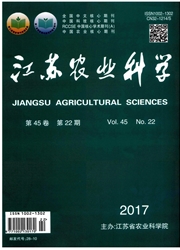

 中文摘要:
中文摘要:
研究了高产大豆品种新大豆1号、石大豆1号和黑农40在不同施氮水平(0、180、360 kg·hm-2)和不同密度(15、30万株·hm-2)处理下植株不同冠层籽粒干物质的积累动态及其产量分布。结果表明:大豆植株上、中、下层籽粒在形成过程中干物质积累的动态变化均极显著拟合于Logistic曲线方程;不同冠层中、下层籽粒到达干物质积累最快的时间比中、上层晚,并且在干物质积累最快时,每粒的日平均增长量也比中、上层小;植株籽粒干物质积累量及最终的产量形成均集中在中、上层籽粒。3个品种下层籽粒干物质积累量在不同施氮处理间差异不显著,中、上层籽粒各施氮处理间差异均显著;增加施氮量主要提高了鼓粒中、后期籽粒干物质积累量。植株中、上层籽粒的干物质积累随着种植密度的增加而增加,而下层的变化不明显;密度的增加对促进植株中、后期籽粒鼓粒效果显著。大豆植株的籽粒产量在垂直方向上为上层〉中层〉下层,平均值分别占单株产量的49.50%、42.94%、7.56%;在水平方向上为主茎〉分枝,平均值分别占单株产量的73.08%和26.92%。
 英文摘要:
英文摘要:
Many soybean yield record have been created in Xinjiang oasis area for its favorable natural conditions,but a full understanding of the physiological response,especially the seed dry matter accumulation(SDMA)under different cultivation practice is lacking.We compared seed dry matter accumulation and distribution by different canopy layers(upper,middle and lower,divided by averaged node number)and seed-fill stage(former,middle and later)of three high-yield genotypes(Xindadou 1,Shidadou 1 and Heinong 40)under three nitrogen levels(0,180,360 kg·ha-1)and two planting densities(15,30×105plants·ha-1)in the field near the experiment stations of Biology College in Shihezi University(44°20′N lat;88°03′E long).Dynamic changes of SDMA were extremely significant fitting for Logistic curve equation.The time of maximum SDMA appeared later and the daily increasing rate at peaked SDMA was slower for lower layer,compared to middle and upper layer.Seed yield were vertically concentrated in middle and upper layer(more than 90 percent)and horizontally concentrated in main stem(more than 70 percent).Nitrogen application significantly increased SDMA in middle and upper layer,but had no obvious effect on lower layer.SDMA in middle and upper layer increased linearly with planting density,especially in later seed-fill stage.Results suggest that optimal nitrogen and planting density mainly promoted SDMA in middle and upper layer,hence,increased seed yield.
 同期刊论文项目
同期刊论文项目
 同项目期刊论文
同项目期刊论文
 期刊信息
期刊信息
